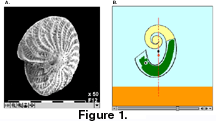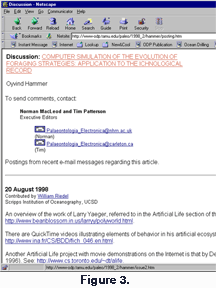LIFE-SPAN AND GROWTH: LIVE
INFORMATION
 In the area of scholarly publishing,
electronic books and journals have already adopted a number of
enhancements made possible by global access to computers, the
Internet, and CD-ROM readers. Palaeontologia Electronica
exploits non-linear access to various parts of its publication,
unlimited use of color, removal of limitations on article size
and number of graphics, the use of movie clips (Figure 1), and the linking of references (backward)
to earlier abstracts and full-text articles on the WWW (Figure 2).
In the area of scholarly publishing,
electronic books and journals have already adopted a number of
enhancements made possible by global access to computers, the
Internet, and CD-ROM readers. Palaeontologia Electronica
exploits non-linear access to various parts of its publication,
unlimited use of color, removal of limitations on article size
and number of graphics, the use of movie clips (Figure 1), and the linking of references (backward)
to earlier abstracts and full-text articles on the WWW (Figure 2). 
One aspect of fully electronic
publication with no printed equivalent, that will certainly
develop early in the next century is the addition of dynamic
elements to traditionally static articles. An obvious example is
the provision of a discussion space that permits readers to
attach comments or elaborations, thus bringing added value to an
article. Such a discussion space could remain open for as long as
the article resides on the Internet (Figure 3).
Another development, which is
foreshadowed by the paper-based Science Citation Index,
will be forward referencing. Forward references provide links to
citations that appear subsequent to an article's publication.
These would enable a reader to track a topic forward in time,
through later publications that cite the original article, and
are being incorporated into journals such as PE as its articles
are cited. The Astrophysical
Journal, for
example, makes extensive use of forward referencing.
 The Ocean Drilling Program is an unusually
tightly integrated, clearly circumscribed program, covering a
broad spectrum of the geological sciences. As such, it provides
an ideal environment for the handling and dissemination of
information. If this opportunity is fully grasped, ODP will
become a model for other programs and disciplines as they
develope electronic publications. Key components of this
well-structured information flow at ODP have already developed--
the Initial Reports (IR) and Scientific Results (SR) volumes, and the JANUS database. The
transition from paper to electronic publication, now underway,
invites closer integration of the existing components, which can
be viewed as a succession.
The Ocean Drilling Program is an unusually
tightly integrated, clearly circumscribed program, covering a
broad spectrum of the geological sciences. As such, it provides
an ideal environment for the handling and dissemination of
information. If this opportunity is fully grasped, ODP will
become a model for other programs and disciplines as they
develope electronic publications. Key components of this
well-structured information flow at ODP have already developed--
the Initial Reports (IR) and Scientific Results (SR) volumes, and the JANUS database. The
transition from paper to electronic publication, now underway,
invites closer integration of the existing components, which can
be viewed as a succession.
- Observations made, and data
collected (JANUS database
- IR volumes (description and
preliminary interpretation)
- SR volumes (further
interpretation and preliminary synthesis)
- Continual development in the
scientific literature - continuing publication within the
ODP structure (see The Issue of Archive)
- Beyond to outside journals,
books, etc.
As an example of the utility of
such an integrated system, electronic links could be provided
from the IRs to corresponding elements of the JANUS database.
From the SR volumes, links might be provided back to the
corresponding parts of IRs, and, if necessary, to additional
JANUS elements, as well as forward to articles in outside
journals. Through these links, readers would be able to follow
the development of interpretations and syntheses, and to see
easily the data and observations on which they are based. This
process is essential for critical science, but is presently
time-consuming, and therefore too rarely done. This is because at
present, the described procedure involves using several different
paper publications and difficult-to-access databases. The linking
of electronic publications and databases will thus be invaluable
to conscientious research.
Stanley Chodorow writes, "In
medieval intellectual culture, works of literature - history,
theology, law, medicine, and literature in the strict sense -
flowed from author to author, across generations, growing and
changing as individual contributors worked on them" (Chodorow, 1997). This was true both figuratively and
literally, as a scholar might scrape a parchment sheet clean of
ink and replace parts of a document. The physical reality of a
document on the WWW allows it to be collaborated on, annotated,
and shared through time in much the same way. Successive versions
can be tracked and cited, because of the stability of file names
and contents, and identification of commentator or reviser.

 In the area of scholarly publishing,
electronic books and journals have already adopted a number of
enhancements made possible by global access to computers, the
Internet, and CD-ROM readers. Palaeontologia Electronica
exploits non-linear access to various parts of its publication,
unlimited use of color, removal of limitations on article size
and number of graphics, the use of movie clips (Figure 1), and the linking of references (backward)
to earlier abstracts and full-text articles on the WWW (Figure 2).
In the area of scholarly publishing,
electronic books and journals have already adopted a number of
enhancements made possible by global access to computers, the
Internet, and CD-ROM readers. Palaeontologia Electronica
exploits non-linear access to various parts of its publication,
unlimited use of color, removal of limitations on article size
and number of graphics, the use of movie clips (Figure 1), and the linking of references (backward)
to earlier abstracts and full-text articles on the WWW (Figure 2). 
 The Ocean Drilling Program is an unusually
tightly integrated, clearly circumscribed program, covering a
broad spectrum of the geological sciences. As such, it provides
an ideal environment for the handling and dissemination of
information. If this opportunity is fully grasped, ODP will
become a model for other programs and disciplines as they
develope electronic publications. Key components of this
well-structured information flow at ODP have already developed--
the
The Ocean Drilling Program is an unusually
tightly integrated, clearly circumscribed program, covering a
broad spectrum of the geological sciences. As such, it provides
an ideal environment for the handling and dissemination of
information. If this opportunity is fully grasped, ODP will
become a model for other programs and disciplines as they
develope electronic publications. Key components of this
well-structured information flow at ODP have already developed--
the